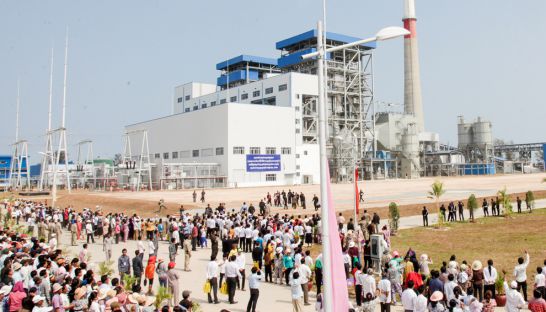Giant coal plant taking shape in Sihanoukville
Giant coal plant taking shape in Sihanoukville
Nearly half of a massive 700-megawatt coal-fired power plant that will fuel the country’s biggest industrial park and feed the national grid is set to be completed by the end of the year, according to officials at the Ministry of Mines and Energy.

The plant, which was first approved in December of 2010, is a development between Cambodian People’s Party Senator Lao Meng Khin’s Cambodia International Investment Development Group (CIIDG) and the obscure Chinese-based Erdos Hongjun Electric Power Co – a company that has amassed most of its wealth in the cashmere industry.
The $383 million joint venture project operates under a 33-year build-own-operate (BOO) scheme in Stung Hav district of Preah Sihanouk province. Construction began in early 2012 and has been carried out quietly, with few aware of the thermal power station’s existence.
Its first and second generating units came online in November 2014 and March 2015, respectively.
Tun Lean, spokesman for Ministry of Mines and Energy and undersecretary of state for the Electricity Authority of Cambodia (EAC), said that the power plant was already partially operational, having successfully installed two 135-megawatt units, with total annual production capacity of 270 megawatts.
“Another unit equalling 135 megawatts will [be] put into operation by the end of this 2016,” he said, adding that the coal supply was imported from Indonesia.
The CIIDG Erdos Hongjun Electric Power plant sits next to Cambodia’s first 100-megawatt coal-fired plant, which was built by Malaysian-owned Leader Universal Holdings and inaugurated in February 2014, he said.
According to Lean, the projects are separate, but occupy the same land concession.
“The power plants in Sihanoukville are connected to the national grid and are used to power the whole country,” he said, adding that the coal-fired plants provide a domestic source of energy to compliment hydropower dams, especially when electricity production is low in the dry season.
Sin Samnang, administrative director for the Ministry of Mines and Energy in Sihanoukville, said that the two power stations have already helped reduce persistently high electricity costs in the area.
“As the result of coal power plants, we can see the cost of electricity is lower than before and access to remote areas has improved,” he said, adding that electricity fees have dropped from 1,000 to 800 riel per kilowatt hour.
Samnang added that it was up to state-owned Electricite du Cambodge (EdC) to decide how the electricity would be dispersed.
However, since 2008, CIIDG has been building the Sihanoukville Special Economic Zone (SSEZ), which is the biggest industrial park in the country, through a partnership with China-based conglomerate Jiangsu Taihu Cambodia International Economic Cooperation Investment Co.
The 11-square-kilometre special economic zone, which last week celebrated its 100th factory during a visit by Prime Minister Hun Sen, expects the CIIDG plant’s coal-fired generators to power all of its industrial demands.
Gu Xia, SSEZ’s marketing manager, said that the coal-fired power plants were developed in conjunction with the special economic zone. He said that CIIDG was building a dedicated $1 million transmission line with a load capacity of 15,000 kilowatts per hour. The line is set to link the power plants to SSEZ by the end of the year.
“The special line is much more stable electricity for the factories in SSEZ,” he said. “Right now, we are using around 6,000 kilowatts per hour from the grid. We encourage our factories to use more electricity so that we can get a cheaper rate.”
According to Xia, electricity in SSEZ is currently priced at $0.20 per kilowatt per hour, but will decrease to $0.15 once the transmission line is installed.
Paul Chapman from the Adelaide Alumni Research Network, a group that drafts policy recommendations, said that it only makes economic sense for Cambodia to use coal power if it is complementary to an existing hydropower plant or the national grid.
Despite environmental concerns, he said “it is unfortunately likely that the coal-fired plant is the cheapest means of backing up the hydro or even adding power to the grid. But if this is about fuelling more power into new places, then it is most unlikely to be economical”.
Provincial coordinator for the rights group Adhoc, Cheap Sotheary, said that it was hard to say whether the coal plants would be beneficial to the local community, especially when it comes to environmental impacts.
“Even if the company promised that their coal power plants will not have an impact, how can we know if the company is following its plan?” she asked.
As for the cost of electricity, Sotheary insisted there had been no decline in prices despite the CIIDG Erdos Hongjun plant being partially operational.
“The cost of electricity has not reduced. It is still the same as it has been for years,” she said.


